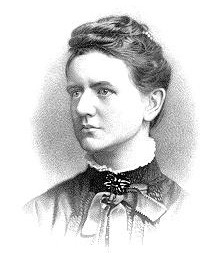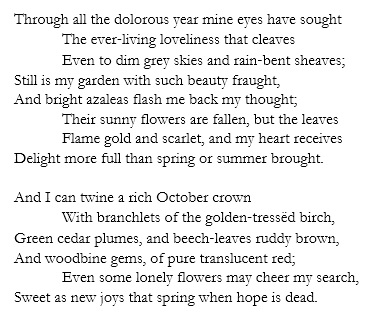As we are plunged into the depths of autumn Constance Naden looks to the beauty in nature to find joy in the world around her. On the surface it is perhaps one of her most commonplace sonnets, as she draws on the usual descriptors of autumn, with its rich red and gold tones. Naden’s facility with descriptive language and handling of metre, however, means that even the listing of trees with the colour of their leaves in the octave remains compelling.
There is a fascinating shifting between emotional states across this sonnet. In the opening lines we move from the ‘dolorous year’ to ‘ever-living loveliness’, the alliterative chime of the latter phrase reinforcing the sense that this is the more accurate view. In the closing lines this movement is echoed, albeit softened, as the melancholy image of ‘lonely flowers’ in fact brings cheer; we have been told in the preceding stanza that the azalea’s ‘sunny flowers are fallen’ and so this potential to find new rather than decaying life brings optimism. In turn these flowers become a simile for ‘new joys that spring when hope is dead’, at which point the reader is drawn outside the autumnal scene and led to reflect more broadly on the relationship between hope and despair. ‘[S]pring’ at this juncture therefore serves to remind us of the cycle of the seasons as well describing joyful movement.
This is also a secular poem, in which Naden chooses not to look to pantheistic or Christian vocabulary to bolster her emotional connection with the forces of nature, in contrast to ‘September, 1880’ and ‘Sunshine’, for example. Here the act of creating a wreath-crown from leaves provides us with an image of the poet clothing herself in garments provided by the trees. In doing so she becomes akin to a dryad, communing and mingling with the trees: the ‘branchlets of the golden‐tressëd birch’ echo the ringlets of a golden-haired woman, the ‘beech‐leaves ruddy brown’ are reminiscent of skin burnished by bracing country air.
It is notable that rather than being in the wider natural setting of most of her sonnets, here Naden is writing explicitly about her own garden: ‘Still is my garden with such beauty fraught’. The connection made between the poet and the plants in this poem is therefore all the more strong, an idea underscored by the ‘bright azaleas [that] flash me back my thought’. This is a poem about finding strength in the power of nature, and in ‘October, 1879’ Naden shows how absolutely she feels her mind and body to be intertwined with the ‘changeful, yet changeless’ world around her.


